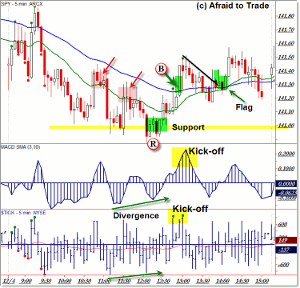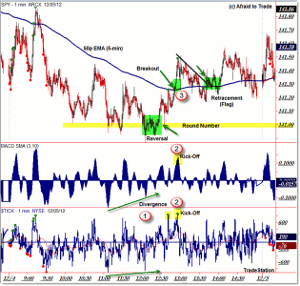Trading trend reversals is one of his favorite set-ups, and here, Corey Rosenbloom of AfraidToTrade.com shares how to recognize the signs and strategies for trading them.
December 4th’s intraday trading session provided an intraday reversal opportunity and I wanted to take a moment to review the main lessons in anticipating—in real time—and then trading an intraday stock market reversal.
Let’s review the steps a market tends to take prior to an intraday reversal and highlight the opportunities that present themselves.
Here is the SPY – S&P 500 ETF – on the 5-min intraday frame:
I’m using the SPY as a reference but you could convert the same logic to the @ES futures or any stock or ETF that you trade.
I’m also showing the 20 EMA (green), 50 EMA (blue), the 3/10 momentum oscillator, and the NYSE TICK for indicators.
The moving averages provide structure (suggesting retracement strategies while price remains trending under these averages, as in the case of the red highlights and arrows at 11:00 am CST and 11:30 am CST).
The momentum oscillator and the NYSE TICK are used to highlight any divergences with price along with any strong impulse or “kick-off” signals (discussed shortly).
A bullish intraday reversal tends to have three main steps:
- Positive Divergences (TICK and/or Momentum)
- Strong impulse up in price, which is confirmed by TICK and Momentum (a “kick-off”)
- A firm breakthrough of the 50-period EMA (5-min) or other trendline resistance
While it’s not necessary, if these chart factors form off a known support level (especially from a higher timeframe or “round number” level like $142), it can increase a trader’s confidence that a reversal may be occurring and thus allow for a more aggressive reversal play.
I labeled these factors on the 1-min chart which helps clarify divergences:
Divergences are common in trending markets (a divergence also took place at 11:30 am), but price did not move to step two or step three by breaking the 50p EMA nor creating a kick-off signal.
A kick-off occurs when price is coming off an intraday low and TICK or the momentum oscillator pushes to new swing highs or even new intraday highs (particularly with TICK).
The kick-off concept is based on the “sign of strength” concept from Richard Wyckoff to describe a strong initial impulse off a market low that is often the start of a new short-term trend.
We see TICK push to new intraday highs (the two green dots) at 12:40 and 1:00 pm as price is NOT making new intraday highs—it is a sign of strength that is not revealed in the price alone.
Finally, in conjunction with the kick-off signal, price breaks above the 50 EMA (blue) to generate a likely reversal signal.
NEXT PAGE: The Trading Strategy |pagebreak|
While it’s important to study the steps a market takes when forming an intraday reversal, one must be able to put these lessons to work in real-time and select one of the main trading strategies, depending on a trader’s experience and aggression (risk-tolerance) level.
Traders often have three specific spots to trade a bullish play with low risk (in case the trend reversal fails):
- Reversal trade off support
- Initial breakout above the 50 EMA (or trendline)
- First retracement or “flag” trade after these steps have occurred.
The most aggressive trade would be buying into a support level when divergences are present. This would be the highest risk spot because the trend could continue, and no kick-off (or breakout) signal has developed.
Some traders prefer the high-risk/high-reward opportunities pure reversal plays allow.
The next spot to enter would be the breakout above the 50 EMA (or associated trendline), which would likely require a resting order above this average.
In this case—and in many others—a kick-off (push to new intraday highs in momentum or TICK) occurs almost at the same time that price breaks above the 50 EMA (5-min).
Generally, breakout trades need confirmation from an increase in volume, momentum, or internals to increase the confidence that the trade will be successful (meaning the market actually breaks out and does not reverse back for a trap).
Finally, the safe spot to play a retracement or “flag” trade would be on the first pullback/retracement after price has completed all three steps (divergence, kick-off, 50 EMA break).
In the 5-min chart above, I labeled an “R” for reversal trade, a “B” for the breakout trade, and “flag” for the retracement trade.
There are a variety of exit signals, but the most common would be selling (exiting) on a push to a prior resistance target, upper Bollinger, or else exiting on the break of a rising 1-min trendline or the break under a 5-min reversal candle low.
The goal of our two-pronged daily Idealized Trades Report, where the first half provides commentaries and lessons like these on the intraday trading action, trading tactics, and broader concepts (narrative) while the second half discusses the higher frame charts to create a game-plan for trading the next session.
Take time each night to learn the lessons from each day’s trading activity (in context of your strategies and how you trade).
Every trading day provides opportunities to learn from price action and improve on your performance so that you can become a better trader each and every day.
By Corey Rosenbloom, CMT, Trader and Blogger, AfraidToTrade.com












